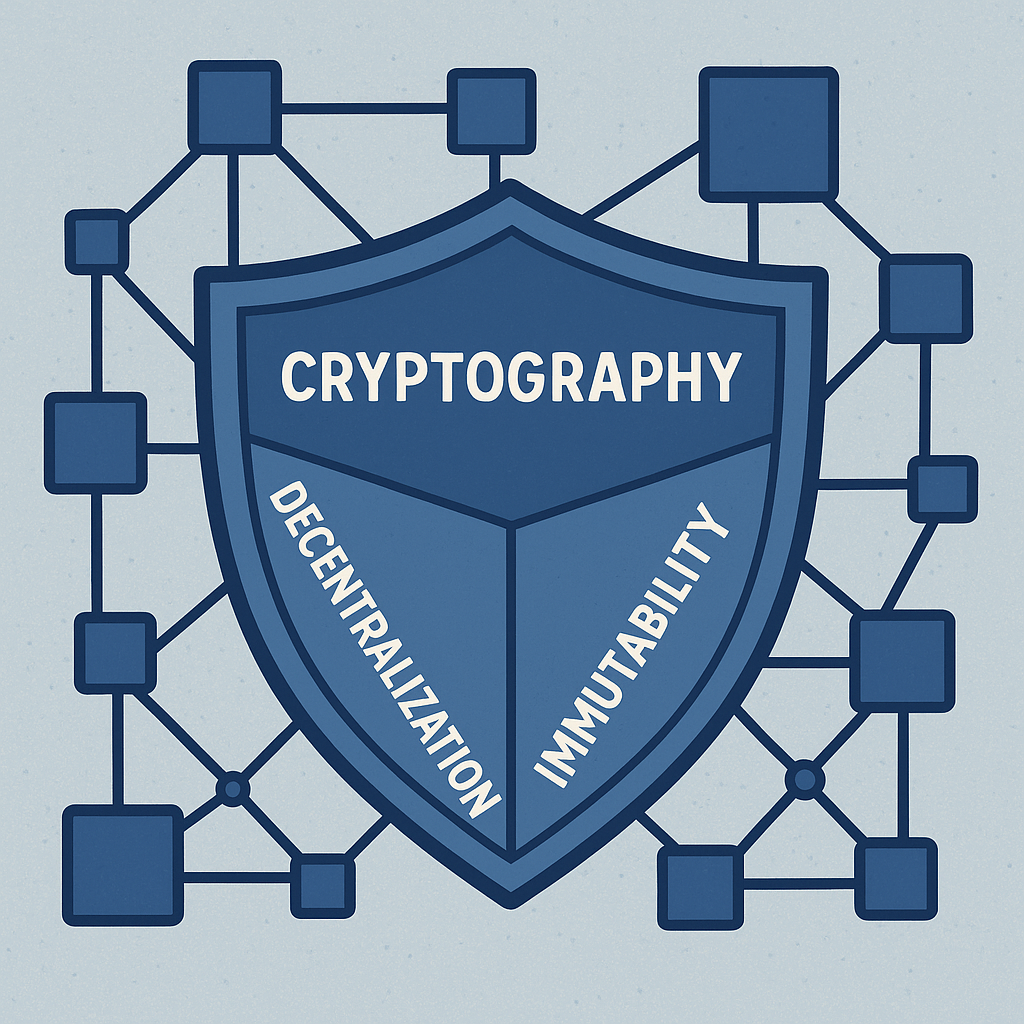What Is Blockchain Security: A Detailed Overview

Want to protect your investments? We explain blockchain technology security, how it works, and proven methods to avoid fraud schemes.
In an era where digital assets worth billions of dollars change hands daily, understanding blockchain security isn’t just important – it’s essential for anyone serious about protecting their investments. Blockchain security encompasses the mechanisms, protocols, and practices designed to protect decentralized networks from hacking, fraud, and unauthorized access.
At its core, blockchain technology was designed with an emphasis on decentralization and immutability, which makes it more resilient to many traditional cybersecurity threats. However, this technological foundation does not make it invulnerable to all attack vectors.
Ensuring blockchain technology security requires a multi-layered approach that includes cryptography, proven consensus algorithms, and continuous network monitoring. Understanding these security principles is essential for anyone managing digital assets in the blockchain ecosystem.
Blockchain Security Overview
The fundamentals of blockchain security lie in the three interconnected principles of the technology itself. A blockchain is a decentralized ledger consisting of data blocks linked by cryptographic hashes. Each block contains the hash of the previous one, which creates a “chain” and makes it virtually impossible to alter data in one block without changing all subsequent ones. This feature, along with the distributed nature of the network, where copies of the ledger are stored on multiple computers (nodes), fosters a high level of user trust.
However, blockchain technology security depends on a number of factors. First and foremost is the type of blockchain used. There are public, private, and hybrid blockchains, and each has its own unique set of security requirements and potential vulnerabilities. In public networks like Bitcoin or Ethereum, security is ensured through broad decentralization and cryptographic proofs, while private networks rely on access control and trust among participants.
To address this challenge, sophisticated cryptographic algorithms are also used to encrypt data within blocks and secure transactions. Asymmetric cryptography, based on public and private key pairs, ensures that only the owner of the private key can perform operations with assets. This makes it impossible to forge signatures or steal funds without access to the private key.
Blockchain Types: Public vs. Private Networks
Understanding the types of blockchains is critically important for assessing blockchain data security. Each type involves trade-offs between decentralization, scalability, and security. The choice of a blockchain’s architecture, whether it’s a public, private, or hybrid network, determines its security methods, the level of trust between participants, and potential vulnerabilities.
These differences dictate how data is protected and how the network responds to external and internal threats.
Public Blockchains
Public blockchains, such as Bitcoin and Ethereum, are fully decentralized and open. Anyone can become a network participant, but the process of verifying transactions and creating new blocks depends on a consensus algorithm. For example, in Proof-of-Work (PoW) networks, this role is performed by miners, while in Proof-of-Stake (PoS) networks, it is handled by validators.
In these systems, changing data requires the consent of the majority of participants, which makes them highly resistant to attacks. A high level of decentralization and transparency provides maximum protection but can lead to scalability issues.
Private Blockchains
Private blockchains, in contrast, are centralized and managed by a single organization or consortium. Network access is restricted, and only authorized participants can read and write data. The security of such ledgers is ensured through strict access control and permissions. Despite less decentralization, they offer higher performance and privacy. The main risk is their centralized nature: if the controlling organization is compromised, the entire network can be at risk.
One of the key aspects to highlight is the fundamental difference between these types of ledgers. In public networks, security is a result of collective effort and economic viability (it’s not profitable for miners or stakers to attack the network, as it would decrease the value of their own assets). In private networks, security is more a matter of trust and internal control, which makes them more susceptible to internal threats. This is an important point for understanding blockchain in cybersecurity.
Understanding Security Trade-offs
Think of choosing between public and private blockchains like deciding between a public bank and a private vault – each fundamentally changes your blockchain technology security approach.
Public blockchains like Bitcoin and Ethereum work like a massive public square where everyone can see what’s happening. They offer incredible security because attacking them would be like trying to rob a bank while thousands of armed guards are watching – technically possible, but so expensive that no rational person would attempt it. The downside? All those security checks slow things down and use a lot of energy, just like airport security makes travel safer but takes time.
Private blockchains flip this equation. Instead of relying on crowds for protection, they work more like a members-only club with strict bouncers at the door. These networks achieve solid blockchain data security by carefully controlling who gets in and trusting that everyone inside will play by the rules. This approach is much faster and uses less energy, but there’s a catch – if someone compromises the organization running the show, the whole system could be at risk.
Many companies today use hybrid approaches, which is like having both a public storefront and a private back office. They use public blockchains when they need maximum transparency and trust, but switch to private networks for day-to-day operations and sensitive information. This flexibility lets organizations build blockchain in cybersecurity solutions that actually fit their real-world needs.
Here’s the key difference: public networks trust math and money (it’s simply too expensive to cheat), while private networks trust people and contracts. Neither approach is automatically better – it’s like asking whether a motorcycle or a truck is superior. The answer depends entirely on what you’re trying to accomplish, how fast you need to go, and what rules you need to follow.
Key Factors Behind Blockchain Security
Blockchain security is not a coincidence; it is the result of carefully designed principles.
- Cryptography. The foundation of any blockchain is cryptography. It ensures data integrity and confidentiality. Hashing technologies guarantee that any, even minor, data corruption will be detected. Asymmetric encryption, also known as public-key cryptography, uses a pair of related keys: a public key and a private key. The public key can be safely shared with others and is used to encrypt data. The private key, known only to the owner, is used for decryption and for creating a digital signature. It is this signature, created with the private key, that proves ownership of assets and allows transactions to be authorized.
- Decentralization. The absence of a single point of failure is a key factor that distinguishes blockchain security from traditional systems. A distributed ledger means that to change data, one must control more than 50% of the network’s computing power or asset stake, which is an extremely difficult and costly task. Consensus algorithms: Protocols determine how network participants agree on the new state of the ledger. These mechanisms reliably protect the blockchain from fraudulent transactions and double-spending attempts.
- Immutability. The immutability of records is a fundamental feature of the distributed ledger. Once a transaction is added to a block and confirmed, it is virtually impossible to change or delete. This significantly increases the level of blockchain in cybersecurity, making blockchain an ideal tool for maintaining immutable records, for example, in supply chains or financial operations.
However, it is important to understand that even with such high security, a blockchain is not completely impenetrable. Many attacks are not aimed at the network itself, but at specific users and their interactions with it. This is why personal responsibility and adherence to basic cyber hygiene rules play a key role.

One of the most vulnerable points is the compromise of a private key. If an attacker gains access to it, they can authorize any transaction and transfer all assets to their own address. This is equivalent to a thief stealing the key to your bank vault. The bank’s security system remains intact, but your assets are lost.
Real-world examples of such incidents include numerous crypto wallet hacks, where hackers use phishing attacks or malicious software to steal private keys and seed phrases. Major hacks, such as the MyEtherWallet incident, or the theft of millions of dollars from individual users, are often linked specifically to the loss of control over the private key.
Types of Attacks on Blockchain
Although the blockchain technology itself is designed with a high degree of reliability, the ecosystem is not invulnerable. There are various types of attacks that can threaten not only the network itself but also its users and the projects built on top of it.
Understanding these threats and their mechanisms is a key element in ensuring blockchain cyber security.
51% Attacks
This is one of the most well-known theoretical threats to decentralized networks with a Proof-of-Work consensus. It occurs when a single miner or a group of miners gains control over more than 50% of the network’s computing power. With such control, they can manipulate transaction confirmations, reverse their own transactions, and obstruct the work of other miners.
While implementing such an attack is extremely costly for large networks like Bitcoin, a real threat comes from large mining pools, whose collective computing power sometimes exceeds 40% of the entire network. This concentration of hash rate in the hands of a few organizations (especially in the past with Chinese pools) creates a centralized vulnerability, making a coordinated attack more likely.
Dusting Attack
A “Dusting Attack” is a privacy attack in which hackers send tiny amounts of cryptocurrency (“dust”) to a large number of addresses. These transactions are often disguised as free token giveaways or airdrops so that the victim doesn’t notice the insignificant transfer. The goal of such attacks is to deanonymize wallet owners by tracking their transactional activity. When a user spends this “dust” along with other funds, hackers can use complex algorithms to analyze the blockchain and link various addresses to a single identity.
This poses a serious threat to privacy and the disclosure of personal payment history.
Replay Attack
A Replay Attack occurs when an attacker intercepts and re-sends (replays) a valid but already completed transaction on another, usually new, network. This threat is especially relevant after a Hard Fork, when a blockchain splits into two separate but initially identical chains. Since the transaction format in both chains remains the same, a transaction sent on one network can be “replayed” on the other, leading to the unauthorized movement of funds.
For example, if a user transferred 10 coins on the new chain, a hacker could take that same transaction and replay it on the old chain to steal 10 coins there. To prevent such attacks, blockchain developers implement special replay protection mechanisms that modify the transaction format in a way that makes it valid only on one of the chains, preventing its execution on the other.
Rug Pull Schemes
Rug Pull has become a common type of fraud. In this case, developers of a new crypto project attract investors by creating a facade of legitimacy, and then suddenly close the project and disappear with all the money. This type of attack is not a technical threat to blockchain security but represents a serious problem in the ecosystem, especially in decentralized finance (DeFi).
The “Rug pull” mechanism often looks like the launch of a new token with an aggressive marketing campaign and promises of high returns. Malicious actors create a liquidity pool using their own and attracted funds. When the token’s value reaches a certain level, they suddenly withdraw all liquidity from the pool, causing the price to crash to zero. Investors are left with nothing, while the fraudsters make millions.
To avoid a Rug pull, be sure to check if the team is anonymous. If the identities of the developers are hidden, it’s a red flag. Also, take time to check the liquidity: it’s important that it is locked. This means that developers won’t be able to instantly withdraw funds from the pool.
Routing Attacks
Routing Attacks are threats aimed at the network infrastructure that supports the blockchain. The goal of such attacks is to intercept, alter, or block traffic that is being transmitted between network nodes. The most common types are:
In a Man-in-the-Middle (MitM) attack, an attacker secretly inserts themselves into the communication channel between two parties, for example, between a user sending a transaction and a blockchain node that confirms it. As a result, the hacker can intercept the transaction, block it, or even alter the data, although this is difficult due to cryptographic signatures. Most often, the goal of MitM attacks is to delay or censor transactions, as well as to collect information.
BGP (Border Gateway Protocol) is a more complex and large-scale type of attack in which an attacker manipulates global internet routes. Using vulnerabilities in the BGP protocol, which manages data transfer across the entire internet, hackers can “announce” themselves as the shortest path to a specific set of IP addresses. For example, they might claim that their servers are the fastest way to blockchain nodes. This allows them to redirect all traffic going to those nodes through themselves.
Such an attack can lead to the isolation of a part of the network, which allows the hacker to perform a 51% attack on the isolated segment.
Phishing Attacks
Phishing Attacks are an old but still very effective form of fraud that targets individual users. Hackers create fake websites, wallets, or send emails to trick users into revealing their private keys, seed phrases, or other confidential information. Like Rug Pull Schemes, this is not a technical vulnerability of the blockchain, but it poses a huge threat to its users.
What Is Important to Understand About Blockchain Security
Remember that blockchain network security is not a protective shield, but a constant battle to protect both the network itself and its users. Yes, decentralization and cryptography make blockchain very reliable, but hackers are not sleeping. They can try to take control with a massive 51% Attacks or discreetly intercept data with Routing Attacks.
However, the most dangerous enemies often lurk outside this digital fortress. These are scammers who use old, proven tricks, such as Phishing Attacks, or new ones, like Rug Pull Schemes, to deceive and steal your money. So the key to security lies in your own awareness of the risks. Your vigilance and knowledge of these threats are your most important and most reliable shield.
Content on BlockPort is provided for informational purposes only and does not constitute financial guidance.
We strive to ensure the accuracy and relevance of the information we share, but we do not guarantee that all content is complete, error-free, or up to date. BlockPort disclaims any liability for losses, mistakes, or actions taken based on the material found on this site.
Always conduct your own research before making financial decisions and consider consulting with a licensed advisor.
For further details, please review our Terms of Use, Privacy Policy, and Disclaimer.



























